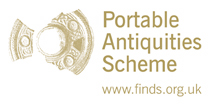File:Staffordshire Moorlands Patera composite image (FindID 49791).jpg
Staffordshire_Moorlands_Patera_composite_image_(FindID_49791).jpg (450 × 65 pixel, dimensione del file: 46 KB, tipo MIME: image/jpeg)
| Questo file e la sua pagina di descrizione (discussione · modifica) si trovano su Wikimedia Commons (?) |
Dettagli
| Staffordshire Moorlands Patera composite image | |||
|---|---|---|---|
| Fotografo |
Stuart Laidlaw, Sally Worrell, 2003-09-29 15:25:39 |
||
| Titolo |
Staffordshire Moorlands Patera composite image |
||
| Descrizione |
English: A 'patera' or handled pan, known as 'The Staffordshire Pan', cast in copper alloy with elaborate enamelled decoration and a Latin inscription below the rim. The body of the vessel is convex and c.2mm thick, and the slightly out-turned rim has a rounded edge, with an external diameter of 89.5mm. There is a diagonal foot-ring with a diameter of 54mm and an internal ledge cast at c.1mm from the base edge, onto which the missing base would have been soldered. Traces of the solder survive on this ledge. The handle is now missing, but judging from other finds it is likely to have been flat and bow-tie shaped and also inlaid with coloured enamel. There are the remains of the solder used to affix the handle on the upper body just below the rim (the soldering scar is c.70mm long). The body of the vessel is decorated with 'Celtic-style' motifs consisting of a curvilinear scrollwork design made up of eight roundels in turquoise and blue enamel enclosing swirling six-armed whirligigs which are inlaid with alternating yellow, red and possibly purple enamel. The whirligigs are made up of three 'leaf-shaped' motifs inlaid with yellow enamel, alternating with larger, curving motifs, one edge of which is 'feathered', and inlaid with red and possibly purple enamel. The areas between the roundels are infilled with triangular motifs inlaid with either red or turquoise enamel. Along the lower edge, these motifs are in alternating red and turquoise enamel, with the turquoise enamel being very well preserved and the red less so. Along the upper edge, the eight motifs are more elaborate with a central copper-alloy extension terminating in a curving, rounded lobe. In each of these motifs, the upper edge to the left of centre has three or four notches cut out in a diagonal line and they are inlaid with turquoise in five of the motifs, there is a slight trace of red in one and no enamel surviving in two of the motifs. A great deal of the enamel survives and the vessel is in a fine condition. |
||
| Luogo rappresentato | (County of findspot) Staffordshire | ||
| Data | tra il 100 e il 199 | ||
| Numero d'inventario |
FindID: 49791 Old ref: WMID-3FE965 Filename: all.jpg |
||
| Attribuzione |
|
||
| Fonte |
https://finds.org.uk/database/ajax/download/id/9863 Catalog: https://finds.org.uk/database/images/image/id/9863 Artefact: https://finds.org.uk/database/artefacts/record/id/49791 |
||
| Licenza (Riusare questo file) |
Attribution-ShareAlike License | ||
| Altre versioni |
|
||
Licenza
- Tu sei libero:
- di condividere – di copiare, distribuire e trasmettere quest'opera
- di modificare – di adattare l'opera
- Alle seguenti condizioni:
- attribuzione – Devi fornire i crediti appropriati, un collegamento alla licenza e indicare se sono state apportate modifiche. Puoi farlo in qualsiasi modo ragionevole, ma non in alcun modo che suggerisca che il licenziante approvi te o il tuo uso.
- condividi allo stesso modo – Se remixi, trasformi o sviluppi il materiale, devi distribuire i tuoi contributi in base alla stessa licenza o compatibile all'originale.
Didascalie
Elementi ritratti in questo file
raffigura
47 022 byte
65 pixel
450 pixel
image/jpeg
d48f300af202b2ff74d25f0e1d6a45d8eceda1a6
Cronologia del file
Fare clic su un gruppo data/ora per vedere il file come si presentava nel momento indicato.
| Data/Ora | Miniatura | Dimensioni | Utente | Commento | |
|---|---|---|---|---|---|
| attuale | 22:53, 23 gen 2017 | 450 × 65 (46 KB) | Fæ | Portable Antiquities Scheme, FASW, FindID: 49791, roman, page 30, batch count 497 |
Pagine che usano questo file
Le seguenti 2 pagine usano questo file:
Utilizzo globale del file
Anche i seguenti wiki usano questo file:
- Usato nelle seguenti pagine di en.wikipedia.org:
- Usato nelle seguenti pagine di nn.wikipedia.org:






